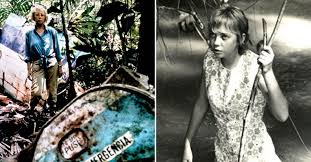How teenager Juliane Koepcke survived a plane crash

Juliane Koepcke, a 17-year-old girl, found herself stuck on a broken airplane that was plunging rapidly towards the Earth. She glanced out and saw the ground, which was 3,000 meters below her. In that moment, she thought that the trees in the thick Peruvian rainforest resembled broccoli heads. She was falling towards them at a speed of 45 meters per second.
During a fierce thunderstorm, the plane Juliane was traveling in got destroyed, and she was still strapped to a row of seats that spun through the air as they descended. She passed out, thinking that her brief glimpse of the vibrant Amazon trees would be her last.
However, Juliane eventually regained consciousness. To her surprise, she found herself beneath the jungle canopy. It was Christmas Day in 1971, and Juliane was wearing a torn sleeveless mini-dress and a single sandal. Despite the incredible odds, she had somehow survived a 3-kilometer fall to the ground with only minor injuries.
Walking away from such a fall seemed like a miracle, but Juliane's struggle for survival had only just begun.
Juliane crash-landed in Peru, finding herself in a jungle filled with dangerous creatures like venomous snakes, mosquitoes, and spiders.
To make her way back to civilization, Juliane, a resilient young woman and the daughter of two well-known zoologists, had to rely on her own resourcefulness.
Juliane was born to German parents in 1954 and grew up in the very Peruvian jungle she now had to escape from. Her father, Hans-Wilhelm Koepcke, was a respected zoologist, and her mother, Maria Koepcke, specialized in studying tropical birds.
Together, her parents established a biological research station called Panguana, where they dedicated themselves to understanding the intricate ecosystem of the lush rainforest.
Growing up on the research station, Juliane considered herself a "jungle child." Contrary to popular belief, she believed that life in the rainforest wasn't as dangerous as people often perceived it to be. In a 2012 interview with the BBC, she expressed, "I learned a lot about life in the rainforest, that it wasn't too dangerous. It's not the green hell that the world always thinks."
While receiving homeschooling at Panguana for several years, Juliane eventually traveled to Lima, the capital of Peru, to complete her education.
In 1971, Juliane and her mother, Maria, made plans to return to Panguana to celebrate Christmas with her father. Maria wished to arrive early, but Juliane was eager to attend her Year 12 dance and graduation ceremony.
Their only available option was to take LANSA Flight 508 on Christmas Eve, which was a turboprop airliner with a capacity of 99 passengers.
Juliane's father was well aware of the infamous reputation of the Lockheed L-188 Electra plane they were about to board. Out of the 170 Electras manufactured, 58 had been involved in accidents or suffered severe mid-air malfunctions.
Despite her father's concerns, Juliane and Maria decided to proceed with their plans and book their tickets, as Christmas was just around the corner.
At first, the flight appeared to be like any other. Juliane and her mother were seated in the second row from the back, with Juliane occupying the window seat while her mother sat in the middle seat. They enjoyed their sandwiches and gazed out of the window at the rainforest scenery.
However, just 15 minutes before their scheduled landing time, the sky suddenly turned pitch black.
"Daylight turns to night and lightning flashes from all directions. People gasp as the plane shakes violently," Juliane wrote in her memoir The Girl Who Fell From The Sky.
"Bags, wrapped gifts, and clothing fall from overhead lockers. Sandwich trays soar through the air, and half-finished drinks spill onto passengers' heads. People scream and cry."
Maria, a nervous flyer, murmured to no-one in particular: "I hope this goes alright".
Juliane remembered witnessing a massive burst of bright white light near the plane's wing, which abruptly sent the aircraft into a steep descent. In that moment, Maria, her mother, spoke with an unnervingly calm voice, saying, "Now it's all over."
Afterward, the chaotic screams of fellow passengers and the deafening roar of the engine inexplicably faded away.
"The next thing I knew, I was no longer inside the cabin," Juliane told the New York Times earlier this year.
"I was outside, in the open air. I hadn't left the plane; the plane had left me."
As Juliane descended into the heart of the Amazon, she found herself alone, likely the only person in her row who had fastened their seat belt.
Once on the jungle floor, Juliane carefully evaluated her injuries. Despite feeling dizzy and disoriented, she suspected she had a concussion. Additionally, she noticed that her collarbone was broken, and she had cuts on her shoulder and calf.
Juliane reflected on the extensive knowledge her parents had imparted to her about the jungle, realizing that there was hardly anything they hadn't taught her.
"I lay there, almost like an embryo for the rest of the day and a whole night, until the next morning," she wrote.
Struggling without her glasses, Juliane faced difficulty in getting her bearings and orienting herself in the unfamiliar surroundings. Her immediate concern was to locate her mother, Maria, who had given her a valuable gift that would prove instrumental in her survival.
Maria, being an ardent lover of animals, had imparted to Juliane the ability to recognize the distinct croaks of frogs and the calls of various birds. As Juliane listened to the familiar sounds of wildlife echoing around her, she realized that she was in the same jungle she had grown up in at Panguana.
Although she was not far from her home, Juliane understood the criticality of not taking a wrong turn that would lead her deeper into the vast expanse of the world's largest rainforest.
Juliane recalled, "There was almost nothing my parents hadn't taught me about the jungle. I just had to retrieve that knowledge from my foggy mind, still affected by the concussion."
Summoning her determination, Juliane managed to extricate herself from the wreckage of the plane seat and began moving forward, despite her impaired vision.
Juliane discovered a dropped packet of candies, which she assumed had fallen from the plane. She followed the river, as her parents had always taught her, hoping to come across other people.
Remembering her father's advice about piranhas being dangerous in shallow waters, Juliane floated in the middle of the stream, anticipating a chance encounter with fellow humans.
As it was the rainy season in the jungle, the incessant downpour made everything damp, making it impossible for Juliane to start a fire. She couldn't find any fruit-bearing trees either, knowing that many jungle plants were poisonous. She made it a point to avoid touching anything unfamiliar.
On the fourth day of her arduous trek through the Amazon, Juliane grew fearful when she heard the call of king vultures. These birds only gathered in large numbers when there was something dead nearby. Following their call, Juliane stumbled upon a disturbing scene.
When the row of seats hit the ground with immense impact, three passengers remained strapped to them, partially buried in the earth.
Juliane approached the passengers, particularly inspecting their toes to ensure that none of them was her mother.
"They were polished, and I took a deep breath. My mother never used polish on her nails," she said.
Despite hearing the search planes looking for her, Juliane remained hidden beneath the dense canopy of the forest, making it difficult for them to locate her.
As the days passed, Juliane's condition worsened. She suffered from sunburn, hunger, and weakness, reaching a point where she contemplated giving up on the tenth day of her journey. She described the harsh reality, saying, "Cold raindrops relentlessly soak through my thin summer dress. The wind sends shivers deep into my bones. During those bleak nights, huddled under a tree or in a bush, I feel completely abandoned."
However, just when she was on the verge of despair, Juliane came across a small hut with a roof made of palm leaves, providing her with a glimmer of hope. Inside the hut, she discovered a can of gasoline.
Juliane also discovered that the gash on her shoulder had become infected with maggots, adding to her physical distress.
Remembering what her father had done to help a family pet, Juliane poured the gasoline over her infected wound as a makeshift treatment.
"The pain was intense as the maggots tried to get further into the wound. I pulled out about 30 maggots and was very proud of myself. I decided to spend the night there," she said.
The following day, Juliane was awakened by the sound of men's voices, prompting her to quickly leave the hut.
The local Peruvian fishermen were frightened by the appearance of the thin, dirty, blonde girl.
"They thought I was a kind of water goddess — a figure from local legend who is a hybrid of a water dolphin and a blonde, white-skinned woman," she said.
But Juliane's parents had given her one final key to her survival: They had taught her Spanish.
"I'm a girl who was in the LANSA crash," she said to them in their native tongue.
"My name is Juliane."
Why did Juliane survive?
Throughout the years, Juliane has grappled with the mystery of being the sole survivor of LANSA Flight 508.
Tragically, out of the 91 other individuals on board, including her mother Maria Koepcke, none survived the crash. It is believed that 14 people managed to survive the initial impact but were unable to journey out of the jungle due to their injuries.
The official cause of the crash was attributed to a deliberate decision by the airline to fly the plane into dangerous weather conditions. Juliane later discovered that the aircraft was constructed entirely from spare parts sourced from other planes, adding to the underlying issues.
By defying the odds and surviving, Juliane became part of a small group of individuals who have fallen from planes and managed to escape with relatively minor injuries.
Just a year after Juliane's incredible survival, a 23-year-old Serbian flight attendant named Vesna Vulović achieved a similar feat. In 1972, during a mid-air explosion, Vesna fell an astonishing 9 kilometers into deep snow in Czechoslovakia. Miraculously, she survived despite suffering a skull fracture, two broken legs, and a broken back.
The reason for Vesna's survival remains a mystery that baffles experts. Juliane, now a biologist, has developed a few theories about how she managed to make it back in one piece. She ponders whether the powerful updraft of the thunderstorm might have slowed her descent, or if the thick canopy of leaves cushioned her landing.
Now, as a biologist, Juliane perceives the world through the same lens as her parents did, embracing the wonders of nature and the interconnectedness of life.
Juliane is now a biologist specialising in bats. She still runs Panguana. (Wikimedia Commons: Cancillería del Perú under Creative Commons 2.0)

 My First News Item
My First News Item My Nine News Item
My Nine News Item